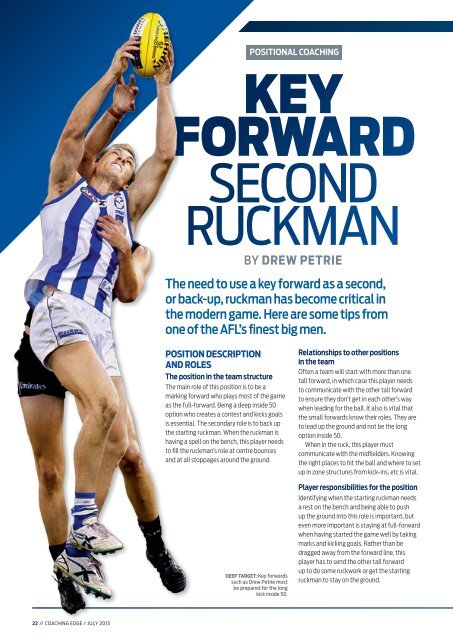Coaching Edge - AFL Community
Coaching Edge - AFL Community
Coaching Edge - AFL Community
You also want an ePaper? Increase the reach of your titles
YUMPU automatically turns print PDFs into web optimized ePapers that Google loves.
POSITIONAL COACHING<br />
Key<br />
forward<br />
second<br />
ruckman<br />
BY DREW PETRIE<br />
The need to use a key forward as a second,<br />
or back-up, ruckman has become critical in<br />
the modern game. Here are some tips from<br />
one of the <strong>AFL</strong>’s finest big men.<br />
Position description<br />
and roles<br />
The position in the team structure<br />
The main role of this position is to be a<br />
marking forward who plays most of the game<br />
as the full-forward. Being a deep inside 50<br />
option who creates a contest and kicks goals<br />
is essential. The secondary role is to back up<br />
the starting ruckman. When the ruckman is<br />
having a spell on the bench, this player needs<br />
to fill the ruckman’s role at centre bounces<br />
and at all stoppages around the ground.<br />
deep target: Key forwards<br />
such as Drew Petrie must<br />
be prepared for the long<br />
kick inside 50.<br />
Relationships to other positions<br />
in the team<br />
Often a team will start with more than one<br />
tall forward, in which case this player needs<br />
to communicate with the other tall forward<br />
to ensure they don’t get in each other’s way<br />
when leading for the ball. It also is vital that<br />
the small forwards know their roles. They are<br />
to lead up the ground and not be the long<br />
option inside 50.<br />
When in the ruck, this player must<br />
communicate with the midfielders. Knowing<br />
the right places to hit the ball and where to set<br />
up in zone structures from kick-ins, etc is vital.<br />
Player responsibilities for the position<br />
Identifying when the starting ruckman needs<br />
a rest on the bench and being able to push<br />
up the ground into this role is important, but<br />
even more important is staying at full-forward<br />
when having started the game well by taking<br />
marks and kicking goals. Rather than be<br />
dragged away from the forward line, this<br />
player has to send the other tall forward<br />
up to do some ruckwork or get the starting<br />
ruckman to stay on the ground.<br />
22 ⁄⁄ COACHING EDGE / JULY 2013

















